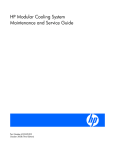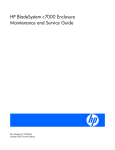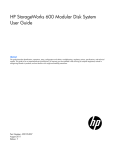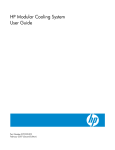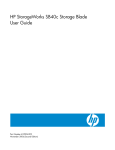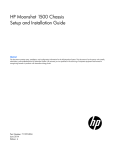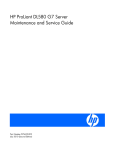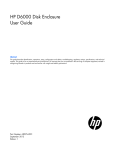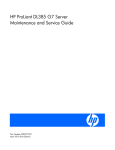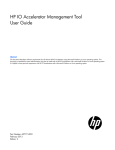Download HP Modular Cooling System Service and Maintain
Transcript
HP Modular Cooling System G2
Maintenance and Service Guide
Part Number 463066-003
February 2010 (Third Edition)
© Copyright 2008, 2010 Hewlett-Packard Development Company, L.P.
The information contained herein is subject to change without notice. The only warranties for HP products and services are set forth in the express
warranty statements accompanying such products and services. Nothing herein should be construed as constituting an additional warranty. HP
shall not be liable for technical or editorial errors or omissions contained herein.
Intended audience
This guide is for an experienced service technician. HP assumes you are qualified in the servicing of computer equipment and trained in
recognizing hazards in products with hazardous energy levels and are familiar with weight and stability precautions for rack installations.
Contents
Customer self repair ...................................................................................................................... 5
Parts only warranty service ......................................................................................................................... 5
Illustrated parts catalog ............................................................................................................... 16
Replaceable spare parts ........................................................................................................................... 16
Removal and replacement procedures ........................................................................................... 20
Overview ............................................................................................................................................... 20
Spare replacement tips ............................................................................................................................ 20
Spare replacement video.......................................................................................................................... 20
Component location ................................................................................................................................ 21
Required tools ......................................................................................................................................... 22
Safety considerations ............................................................................................................................... 23
Rack warnings and cautions ........................................................................................................... 23
Preparation procedures ............................................................................................................................ 23
Disconnecting the power ................................................................................................................ 23
Turning off the water ...................................................................................................................... 24
Draining water from the MCS G2 unit .............................................................................................. 24
AC transfer switch ................................................................................................................................... 25
Removing the AC transfer switch ..................................................................................................... 25
Replacing the AC transfer switch ..................................................................................................... 26
Air bleeder valve..................................................................................................................................... 27
Removing the air bleeder valve ....................................................................................................... 27
Replacing the air bleeder valve ....................................................................................................... 28
Bottom fan unit ........................................................................................................................................ 28
Removing the bottom fan unit .......................................................................................................... 29
Replacing the bottom fan unit .......................................................................................................... 29
Condensation pump ................................................................................................................................ 30
Removing the condensation pump.................................................................................................... 30
Replacing the condensation pump ................................................................................................... 32
Fan controller.......................................................................................................................................... 34
Removing the fan controller............................................................................................................. 34
Replacing the fan controller ............................................................................................................ 35
Fan unit ................................................................................................................................................. 36
Removing the fan unit..................................................................................................................... 36
Replacing the fan unit .................................................................................................................... 37
Flow meter sensor ................................................................................................................................... 38
Removing the flow meter sensor....................................................................................................... 38
Replacing the flow meter sensor ...................................................................................................... 40
Front automatic door release .................................................................................................................... 44
Removing the front automatic door release........................................................................................ 44
Replacing the front automatic door release ....................................................................................... 45
Management module ............................................................................................................................... 46
Removing the management module .................................................................................................. 46
Replacing the management module ................................................................................................. 48
Operator display..................................................................................................................................... 49
Removing the operator display ........................................................................................................ 49
Replacing the operator display ........................................................................................................ 51
Rear automatic door release ..................................................................................................................... 53
Removing the rear automatic door release ........................................................................................ 54
Replacing the rear automatic door release ........................................................................................ 55
Water controller ...................................................................................................................................... 57
Removing the water controller ......................................................................................................... 57
Replacing the water controller ......................................................................................................... 59
Water level sensors ................................................................................................................................. 61
Removing the water level sensors ..................................................................................................... 61
Replacing the water level sensors .................................................................................................... 62
Water valve ........................................................................................................................................... 65
Removing the water valve ............................................................................................................... 65
Replacing the water valve ............................................................................................................... 69
Operation checklist.................................................................................................................................. 73
Reconnecting the main water hoses.................................................................................................. 73
Reconnecting the power ................................................................................................................. 73
Restoring water flow ...................................................................................................................... 74
Maintenance .............................................................................................................................. 75
Maintenance and service ......................................................................................................................... 75
Air and water heat exchanger maintenance ...................................................................................... 75
Water quality requirements and specifications ............................................................................................ 75
Acceptable water quality specifications ............................................................................................ 75
Frost damage ................................................................................................................................ 76
Water precautions ......................................................................................................................... 76
Plumbing materials to avoid ............................................................................................................ 77
Condensation management ...................................................................................................................... 77
Diagnostic tools ...................................................................................................................................... 77
Troubleshooting .......................................................................................................................... 78
HP Modular Cooling System troubleshooting ............................................................................................... 78
Specifications ............................................................................................................................. 79
MCS specifications .................................................................................................................................. 79
Thermal and air flow performance ................................................................................................... 80
Environmental specifications ........................................................................................................... 80
HP 10642 G2 Rack specifications ............................................................................................................. 80
Acronyms and abbreviations ........................................................................................................ 81
Index ......................................................................................................................................... 82
Customer self repair
HP products are designed with many Customer Self Repair (CSR) parts to minimize repair time and allow
for greater flexibility in performing defective parts replacement. If during the diagnosis period HP (or HP
service providers or service partners) identifies that the repair can be accomplished by the use of a CSR
part, HP will ship that part directly to you for replacement. There are two categories of CSR parts:
•
Mandatory—Parts for which customer self repair is mandatory. If you request HP to replace these
parts, you will be charged for the travel and labor costs of this service.
•
Optional—Parts for which customer self repair is optional. These parts are also designed for
customer self repair. If, however, you require that HP replace them for you, there may or may not be
additional charges, depending on the type of warranty service designated for your product.
NOTE: Some HP parts are not designed for customer self repair. In order to satisfy the customer warranty,
HP requires that an authorized service provider replace the part. These parts are identified as "No" in the
Illustrated Parts Catalog.
Based on availability and where geography permits, CSR parts will be shipped for next business day
delivery. Same day or four-hour delivery may be offered at an additional charge where geography
permits. If assistance is required, you can call the HP Technical Support Center and a technician will help
you over the telephone. HP specifies in the materials shipped with a replacement CSR part whether a
defective part must be returned to HP. In cases where it is required to return the defective part to HP, you
must ship the defective part back to HP within a defined period of time, normally five (5) business days.
The defective part must be returned with the associated documentation in the provided shipping material.
Failure to return the defective part may result in HP billing you for the replacement. With a customer self
repair, HP will pay all shipping and part return costs and determine the courier/carrier to be used.
For more information about HP's Customer Self Repair program, contact your local service provider. For
the North American program, refer to the HP website (http://www.hp.com/go/selfrepair).
Parts only warranty service
Your HP Limited Warranty may include a parts only warranty service. Under the terms of parts only
warranty service, HP will provide replacement parts free of charge.
For parts only warranty service, CSR part replacement is mandatory. If you request HP to replace these
parts, you will be charged for the travel and labor costs of this service.
Réparation par le client (CSR)
Les produits HP comportent de nombreuses pièces CSR (Customer Self Repair = réparation par le client)
afin de minimiser les délais de réparation et faciliter le remplacement des pièces défectueuses. Si pendant
la période de diagnostic, HP (ou ses partenaires ou mainteneurs agréés) détermine que la réparation peut
être effectuée à l'aide d'une pièce CSR, HP vous l'envoie directement. Il existe deux catégories de pièces
CSR:
Customer self repair 5
Obligatoire - Pièces pour lesquelles la réparation par le client est obligatoire. Si vous demandez à HP de
remplacer ces pièces, les coûts de déplacement et main d'œuvre du service vous seront facturés.
Facultatif - Pièces pour lesquelles la réparation par le client est facultative. Ces pièces sont également
conçues pour permettre au client d'effectuer lui-même la réparation. Toutefois, si vous demandez à HP de
remplacer ces pièces, l'intervention peut ou non vous être facturée, selon le type de garantie applicable à
votre produit.
REMARQUE: Certaines pièces HP ne sont pas conçues pour permettre au client d'effectuer lui-même la
réparation. Pour que la garantie puisse s'appliquer, HP exige que le remplacement de la pièce soit
effectué par un Mainteneur Agréé. Ces pièces sont identifiées par la mention "Non" dans le Catalogue
illustré.
Les pièces CSR sont livrées le jour ouvré suivant, dans la limite des stocks disponibles et selon votre
situation géographique. Si votre situation géographique le permet et que vous demandez une livraison le
jour même ou dans les 4 heures, celle-ci vous sera facturée. Pour bénéficier d'une assistance
téléphonique, appelez le Centre d'assistance technique HP. Dans les documents envoyés avec la pièce de
rechange CSR, HP précise s'il est nécessaire de lui retourner la pièce défectueuse. Si c'est le cas, vous
devez le faire dans le délai indiqué, généralement cinq (5) jours ouvrés. La pièce et sa documentation
doivent être retournées dans l'emballage fourni. Si vous ne retournez pas la pièce défectueuse, HP se
réserve le droit de vous facturer les coûts de remplacement. Dans le cas d'une pièce CSR, HP supporte
l'ensemble des frais d'expédition et de retour, et détermine la société de courses ou le transporteur à
utiliser.
Pour plus d'informations sur le programme CSR de HP, contactez votre Mainteneur Agrée local. Pour plus
d'informations sur ce programme en Amérique du Nord, consultez le site Web HP
(http://www.hp.com/go/selfrepair).
Service de garantie "pièces seules"
Votre garantie limitée HP peut inclure un service de garantie "pièces seules". Dans ce cas, les pièces de
rechange fournies par HP ne sont pas facturées.
Dans le cadre de ce service, la réparation des pièces CSR par le client est obligatoire. Si vous demandez
à HP de remplacer ces pièces, les coûts de déplacement et main d'œuvre du service vous seront facturés.
Riparazione da parte del cliente
Per abbreviare i tempi di riparazione e garantire una maggiore flessibilità nella sostituzione di parti
difettose, i prodotti HP sono realizzati con numerosi componenti che possono essere riparati direttamente
dal cliente (CSR, Customer Self Repair). Se in fase di diagnostica HP (o un centro di servizi o di
assistenza HP) identifica il guasto come riparabile mediante un ricambio CSR, HP lo spedirà direttamente
al cliente per la sostituzione. Vi sono due categorie di parti CSR:
Obbligatorie – Parti che devono essere necessariamente riparate dal cliente. Se il cliente ne affida la
riparazione ad HP, deve sostenere le spese di spedizione e di manodopera per il servizio.
Opzionali – Parti la cui riparazione da parte del cliente è facoltativa. Si tratta comunque di componenti
progettati per questo scopo. Se tuttavia il cliente ne richiede la sostituzione ad HP, potrebbe dover
sostenere spese addizionali a seconda del tipo di garanzia previsto per il prodotto.
Customer self repair 6
NOTA: alcuni componenti HP non sono progettati per la riparazione da parte del cliente. Per rispettare
la garanzia, HP richiede che queste parti siano sostituite da un centro di assistenza autorizzato. Tali parti
sono identificate da un "No" nel Catalogo illustrato dei componenti.
In base alla disponibilità e alla località geografica, le parti CSR vengono spedite con consegna entro il
giorno lavorativo seguente. La consegna nel giorno stesso o entro quattro ore è offerta con un
supplemento di costo solo in alcune zone. In caso di necessità si può richiedere l'assistenza telefonica di
un addetto del centro di supporto tecnico HP. Nel materiale fornito con una parte di ricambio CSR, HP
specifica se il cliente deve restituire dei componenti. Qualora sia richiesta la resa ad HP del componente
difettoso, lo si deve spedire ad HP entro un determinato periodo di tempo, generalmente cinque (5) giorni
lavorativi. Il componente difettoso deve essere restituito con la documentazione associata nell'imballo di
spedizione fornito. La mancata restituzione del componente può comportare la fatturazione del ricambio
da parte di HP. Nel caso di riparazione da parte del cliente, HP sostiene tutte le spese di spedizione e
resa e sceglie il corriere/vettore da utilizzare.
Per ulteriori informazioni sul programma CSR di HP contattare il centro di assistenza di zona. Per il
programma in Nord America fare riferimento al sito Web HP (http://www.hp.com/go/selfrepair).
Servizio di garanzia per i soli componenti
La garanzia limitata HP può includere un servizio di garanzia per i soli componenti. Nei termini di
garanzia del servizio per i soli componenti, HP fornirà gratuitamente le parti di ricambio.
Per il servizio di garanzia per i soli componenti è obbligatoria la formula CSR che prevede la riparazione
da parte del cliente. Se il cliente invece richiede la sostituzione ad HP, dovrà sostenere le spese di
spedizione e di manodopera per il servizio.
Customer Self Repair
HP Produkte enthalten viele CSR-Teile (Customer Self Repair), um Reparaturzeiten zu minimieren und
höhere Flexibilität beim Austausch defekter Bauteile zu ermöglichen. Wenn HP (oder ein HP
Servicepartner) bei der Diagnose feststellt, dass das Produkt mithilfe eines CSR-Teils repariert werden
kann, sendet Ihnen HP dieses Bauteil zum Austausch direkt zu. CSR-Teile werden in zwei Kategorien
unterteilt:
Zwingend – Teile, für die das Customer Self Repair-Verfahren zwingend vorgegeben ist. Wenn Sie den
Austausch dieser Teile von HP vornehmen lassen, werden Ihnen die Anfahrt- und Arbeitskosten für diesen
Service berechnet.
Optional – Teile, für die das Customer Self Repair-Verfahren optional ist. Diese Teile sind auch für
Customer Self Repair ausgelegt. Wenn Sie jedoch den Austausch dieser Teile von HP vornehmen lassen
möchten, können bei diesem Service je nach den für Ihr Produkt vorgesehenen Garantiebedingungen
zusätzliche Kosten anfallen.
HINWEIS: Einige Teile sind nicht für Customer Self Repair ausgelegt. Um den Garantieanspruch des
Kunden zu erfüllen, muss das Teil von einem HP Servicepartner ersetzt werden. Im illustrierten Teilekatalog
sind diese Teile mit „No“ bzw. „Nein“ gekennzeichnet.
CSR-Teile werden abhängig von der Verfügbarkeit und vom Lieferziel am folgenden Geschäftstag
geliefert. Für bestimmte Standorte ist eine Lieferung am selben Tag oder innerhalb von vier Stunden gegen
einen Aufpreis verfügbar. Wenn Sie Hilfe benötigen, können Sie das HP technische Support Center
Customer self repair 7
anrufen und sich von einem Mitarbeiter per Telefon helfen lassen. Den Materialien, die mit einem CSRErsatzteil geliefert werden, können Sie entnehmen, ob das defekte Teil an HP zurückgeschickt werden
muss. Wenn es erforderlich ist, das defekte Teil an HP zurückzuschicken, müssen Sie dies innerhalb eines
vorgegebenen Zeitraums tun, in der Regel innerhalb von fünf (5) Geschäftstagen. Das defekte Teil muss
mit der zugehörigen Dokumentation in der Verpackung zurückgeschickt werden, die im Lieferumfang
enthalten ist. Wenn Sie das defekte Teil nicht zurückschicken, kann HP Ihnen das Ersatzteil in Rechnung
stellen. Im Falle von Customer Self Repair kommt HP für alle Kosten für die Lieferung und Rücksendung auf
und bestimmt den Kurier-/Frachtdienst.
Weitere Informationen über das HP Customer Self Repair Programm erhalten Sie von Ihrem Servicepartner
vor Ort. Informationen über das CSR-Programm in Nordamerika finden Sie auf der HP Website unter
(http://www.hp.com/go/selfrepair).
Parts-only Warranty Service (Garantieservice
ausschließlich für Teile)
Ihre HP Garantie umfasst möglicherweise einen Parts-only Warranty Service (Garantieservice
ausschließlich für Teile). Gemäß den Bestimmungen des Parts-only Warranty Service stellt HP Ersatzteile
kostenlos zur Verfügung.
Für den Parts-only Warranty Service ist das CSR-Verfahren zwingend vorgegeben. Wenn Sie den
Austausch dieser Teile von HP vornehmen lassen, werden Ihnen die Anfahrt- und Arbeitskosten für diesen
Service berechnet.
Reparaciones del propio cliente
Los productos de HP incluyen muchos componentes que el propio usuario puede reemplazar (Customer
Self Repair, CSR) para minimizar el tiempo de reparación y ofrecer una mayor flexibilidad a la hora de
realizar sustituciones de componentes defectuosos. Si, durante la fase de diagnóstico, HP (o los
proveedores o socios de servicio de HP) identifica que una reparación puede llevarse a cabo mediante el
uso de un componente CSR, HP le enviará dicho componente directamente para que realice su
sustitución. Los componentes CSR se clasifican en dos categorías:
•
Obligatorio: componentes para los que la reparación por parte del usuario es obligatoria. Si solicita
a HP que realice la sustitución de estos componentes, tendrá que hacerse cargo de los gastos de
desplazamiento y de mano de obra de dicho servicio.
•
Opcional: componentes para los que la reparación por parte del usuario es opcional. Estos
componentes también están diseñados para que puedan ser reparados por el usuario. Sin embargo,
si precisa que HP realice su sustitución, puede o no conllevar costes adicionales, dependiendo del
tipo de servicio de garantía correspondiente al producto.
NOTA: Algunos componentes no están diseñados para que puedan ser reparados por el usuario. Para
que el usuario haga valer su garantía, HP pone como condición que un proveedor de servicios
autorizado realice la sustitución de estos componentes. Dichos componentes se identifican con la palabra
"No" en el catálogo ilustrado de componentes.
Según la disponibilidad y la situación geográfica, los componentes CSR se enviarán para que lleguen a
su destino al siguiente día laborable. Si la situación geográfica lo permite, se puede solicitar la entrega
en el mismo día o en cuatro horas con un coste adicional. Si precisa asistencia técnica, puede llamar al
Customer self repair 8
Centro de asistencia técnica de HP y recibirá ayuda telefónica por parte de un técnico. Con el envío de
materiales para la sustitución de componentes CSR, HP especificará si los componentes defectuosos
deberán devolverse a HP. En aquellos casos en los que sea necesario devolver algún componente a HP,
deberá hacerlo en el periodo de tiempo especificado, normalmente cinco días laborables. Los
componentes defectuosos deberán devolverse con toda la documentación relacionada y con el embalaje
de envío. Si no enviara el componente defectuoso requerido, HP podrá cobrarle por el de sustitución. En
el caso de todas sustituciones que lleve a cabo el cliente, HP se hará cargo de todos los gastos de envío
y devolución de componentes y escogerá la empresa de transporte que se utilice para dicho servicio.
Para obtener más información acerca del programa de Reparaciones del propio cliente de HP, póngase
en contacto con su proveedor de servicios local. Si está interesado en el programa para Norteamérica,
visite la página web de HP siguiente (http://www.hp.com/go/selfrepair).
Servicio de garantía exclusivo de componentes
La garantía limitada de HP puede que incluya un servicio de garantía exclusivo de componentes. Según
las condiciones de este servicio exclusivo de componentes, HP le facilitará los componentes de repuesto
sin cargo adicional alguno.
Para este servicio de garantía exclusivo de componentes, es obligatoria la sustitución de componentes
por parte del usuario (CSR). Si solicita a HP que realice la sustitución de estos componentes, tendrá que
hacerse cargo de los gastos de desplazamiento y de mano de obra de dicho servicio.
Customer Self Repair
Veel onderdelen in HP producten zijn door de klant zelf te repareren, waardoor de reparatieduur tot een
minimum beperkt kan blijven en de flexibiliteit in het vervangen van defecte onderdelen groter is. Deze
onderdelen worden CSR-onderdelen (Customer Self Repair) genoemd. Als HP (of een HP Service Partner)
bij de diagnose vaststelt dat de reparatie kan worden uitgevoerd met een CSR-onderdeel, verzendt HP
dat onderdeel rechtstreeks naar u, zodat u het defecte onderdeel daarmee kunt vervangen. Er zijn twee
categorieën CSR-onderdelen:
Verplicht: Onderdelen waarvoor reparatie door de klant verplicht is. Als u HP verzoekt deze onderdelen
voor u te vervangen, worden u voor deze service reiskosten en arbeidsloon in rekening gebracht.
Optioneel: Onderdelen waarvoor reparatie door de klant optioneel is. Ook deze onderdelen zijn
ontworpen voor reparatie door de klant. Als u echter HP verzoekt deze onderdelen voor u te vervangen,
kunnen daarvoor extra kosten in rekening worden gebracht, afhankelijk van het type garantieservice voor
het product.
OPMERKING: Sommige HP onderdelen zijn niet ontwikkeld voor reparatie door de klant. In verband met
de garantievoorwaarden moet het onderdeel door een geautoriseerde Service Partner worden vervangen.
Deze onderdelen worden in de geïllustreerde onderdelencatalogus aangemerkt met "Nee".
Afhankelijk van de leverbaarheid en de locatie worden CSR-onderdelen verzonden voor levering op de
eerstvolgende werkdag. Levering op dezelfde dag of binnen vier uur kan tegen meerkosten worden
aangeboden, indien dit mogelijk is gezien de locatie. Indien assistentie gewenst is, belt u een HP Service
Partner om via de telefoon technische ondersteuning te ontvangen. HP vermeldt in de documentatie bij het
vervangende CSR-onderdeel of het defecte onderdeel aan HP moet worden geretourneerd. Als het defecte
onderdeel aan HP moet worden teruggezonden, moet u het defecte onderdeel binnen een bepaalde
periode, gewoonlijk vijf (5) werkdagen, retourneren aan HP. Het defecte onderdeel moet met de
Customer self repair 9
bijbehorende documentatie worden geretourneerd in het meegeleverde verpakkingsmateriaal. Als u het
defecte onderdeel niet terugzendt, kan HP u voor het vervangende onderdeel kosten in rekening brengen.
Bij reparatie door de klant betaalt HP alle verzendkosten voor het vervangende en geretourneerde
onderdeel en kiest HP zelf welke koerier/transportonderneming hiervoor wordt gebruikt.
Neem contact op met een Service Partner voor meer informatie over het Customer Self Repair programma
van HP. Informatie over Service Partners vindt u op de HP website (http://www.hp.com/go/selfrepair).
Garantieservice "Parts Only"
Het is mogelijk dat de HP garantie alleen de garantieservice "Parts Only" omvat. Volgens de bepalingen
van de Parts Only garantieservice zal HP kosteloos vervangende onderdelen ter beschikking stellen.
Voor de Parts Only garantieservice is vervanging door CSR-onderdelen verplicht. Als u HP verzoekt deze
onderdelen voor u te vervangen, worden u voor deze service reiskosten en arbeidsloon in rekening
gebracht.
Reparo feito pelo cliente
Os produtos da HP são projetados com muitas peças para reparo feito pelo cliente (CSR) de modo a
minimizar o tempo de reparo e permitir maior flexibilidade na substituição de peças com defeito. Se,
durante o período de diagnóstico, a HP (ou fornecedores/parceiros de serviço da HP) concluir que o
reparo pode ser efetuado pelo uso de uma peça CSR, a peça de reposição será enviada diretamente ao
cliente. Existem duas categorias de peças CSR:
Obrigatória – Peças cujo reparo feito pelo cliente é obrigatório. Se desejar que a HP substitua essas
peças, serão cobradas as despesas de transporte e mão-de-obra do serviço.
Opcional – Peças cujo reparo feito pelo cliente é opcional. Essas peças também são projetadas para o
reparo feito pelo cliente. No entanto, se desejar que a HP as substitua, pode haver ou não a cobrança
de taxa adicional, dependendo do tipo de serviço de garantia destinado ao produto.
OBSERVAÇÃO: Algumas peças da HP não são projetadas para o reparo feito pelo cliente. A fim de
cumprir a garantia do cliente, a HP exige que um técnico autorizado substitua a peça. Essas peças estão
identificadas com a marca "No" (Não), no catálogo de peças ilustrado.
Conforme a disponibilidade e o local geográfico, as peças CSR serão enviadas no primeiro dia útil após
o pedido. Onde as condições geográficas permitirem, a entrega no mesmo dia ou em quatro horas pode
ser feita mediante uma taxa adicional. Se precisar de auxílio, entre em contato com o Centro de suporte
técnico da HP para que um técnico o ajude por telefone. A HP especifica nos materiais fornecidos com a
peça CSR de reposição se a peça com defeito deve ser devolvida à HP. Nos casos em que isso for
necessário, é preciso enviar a peça com defeito à HP dentro do período determinado, normalmente
cinco (5) dias úteis. A peça com defeito deve ser enviada com a documentação correspondente no
material de transporte fornecido. Caso não o faça, a HP poderá cobrar a reposição. Para as peças de
reparo feito pelo cliente, a HP paga todas as despesas de transporte e de devolução da peça e
determina a transportadora/serviço postal a ser utilizado.
Para obter mais informações sobre o programa de reparo feito pelo cliente da HP, entre em contato com
o fornecedor de serviços local. Para o programa norte-americano, visite o site da HP
(http://www.hp.com/go/selfrepair).
Customer self repair 10
Serviço de garantia apenas para peças
A garantia limitada da HP pode incluir um serviço de garantia apenas para peças. Segundo os termos
do serviço de garantia apenas para peças, a HP fornece as peças de reposição sem cobrar nenhuma
taxa.
No caso desse serviço, a substituição de peças CSR é obrigatória. Se desejar que a HP substitua essas
peças, serão cobradas as despesas de transporte e mão-de-obra do serviço.
Customer self repair 11
Customer self repair 12
Customer self repair 13
Customer self repair 14
Customer self repair 15
Illustrated parts catalog
Replaceable spare parts
The replaceable spare parts for the HP Modular Cooling System G2 unit are listed in the following table.
Item
Description
Spare part
number
Customer self repair
1
SPS-FLOWMETER, REPAIR, MCS-G2
463364-001
Optional2
2
SPS-VALVE, VARIABLE, MCS-G2
463360-001
No3
3
SPS-PUMP, CONDENSATION, MCS-G2
463361-001
Optional2
4
SPS-SENSORS, LEVEL, WATER, MCS-G2
463366-001
Optional2
Illustrated parts catalog
16
Item
Description
Spare part
number
Customer self repair
5
SPS-CONTROL, WATER, GRP, MCS-G2
463359-001
Optional2
6
SPS-FAN, MAIN, MCS-G2
463362-001
Optional2
7
SPS-CONTROLLER, FAN, MCS-G2
468279-001
Optional2
8
SPS-AIR BLEEDER, MCS-G2
463367-001
Optional2
9
SPS-DISPLAY, OPERATOR, MCS-G2
463355-001
Optional2
10
SPS-MANAGEMENT MODULE, MCS-G2
463357-001
Optional2
11
SPS-TRANSFER SWITCH, AC, MCS-G2
463358-001
Optional2
12
SPS-WHOLE MCS UNIT, MCS-G2
463356-001
Optional2
∗
SPS-KIT, DOOR RELEASE
463365-001
Optional2
∗
SPS-HOOKUP KIT MCS G2**
611040-001
Optional2
*
SPS-ELECTRICAL HOOKUP, MCS-G2***
463369-001
Optional2
*Not shown
**The Main hose kit contains the hardware required to repair the main hoses. For more information, see the HP
Modular Cooling System Hook-Up Kit Installation Instructions.
***The Electrical kit contains replacement power and network cables.
1
Mandatory—Parts for which customer self repair is mandatory. If you request HP to replace these parts, you will be
charged for the travel and labor costs of this service.
2
Optional—Parts for which customer self repair is optional. These parts are also designed for customer self repair. If,
however, you require that HP replace them for you, there may or may not be additional charges, depending on the
type of warranty service designated for your product.
3
No—Some HP parts are not designed for customer self repair. In order to satisfy the customer warranty, HP requires
that an authorized service provider replace the part. These parts are identified as "No" in the Illustrated Parts
Catalog.
Mandatory: Obligatoire—Pièces pour lesquelles la réparation par le client est obligatoire. Si vous demandez à HP
de remplacer ces pièces, les coûts de déplacement et main d'œuvre du service vous seront facturés.
2
Optional: Facultatif—Pièces pour lesquelles la réparation par le client est facultative. Ces pièces sont également
conçues pour permettre au client d'effectuer lui-même la réparation. Toutefois, si vous demandez à HP de remplacer
ces pièces, l'intervention peut ou non vous être facturée, selon le type de garantie applicable à votre produit.
3
No: Non—Certaines pièces HP ne sont pas conçues pour permettre au client d'effectuer lui-même la réparation. Pour
que la garantie puisse s'appliquer, HP exige que le remplacement de la pièce soit effectué par un Mainteneur Agréé.
Ces pièces sont identifiées par la mention “Non” dans le Catalogue illustré.
1
Mandatory: Obbligatorie—Parti che devono essere necessariamente riparate dal cliente. Se il cliente ne affida la
riparazione ad HP, deve sostenere le spese di spedizione e di manodopera per il servizio.
2
Optional: Opzionali—Parti la cui riparazione da parte del cliente è facoltativa. Si tratta comunque di componenti
progettati per questo scopo. Se tuttavia il cliente ne richiede la sostituzione ad HP, potrebbe dover sostenere spese
addizionali a seconda del tipo di garanzia previsto per il prodotto.
3
No: Non CSR—Alcuni componenti HP non sono progettati per la riparazione da parte del cliente. Per rispettare la
garanzia, HP richiede che queste parti siano sostituite da un centro di assistenza autorizzato. Tali parti sono
identificate da un “No” nel Catalogo illustrato dei componenti.
1
Mandatory: Zwingend—Teile, die im Rahmen des Customer Self Repair Programms ersetzt werden müssen. Wenn
Sie diese Teile von HP ersetzen lassen, werden Ihnen die Versand- und Arbeitskosten für diesen Service berechnet.
2
Optional: Optional—Teile, für die das Customer Self Repair-Verfahren optional ist. Diese Teile sind auch für
Customer Self Repair ausgelegt. Wenn Sie jedoch den Austausch dieser Teile von HP vornehmen lassen möchten,
können bei diesem Service je nach den für Ihr Produkt vorgesehenen Garantiebedingungen zusätzliche Kosten
anfallen.
1
Illustrated parts catalog
17
No: Kein—Einige Teile sind nicht für Customer Self Repair ausgelegt. Um den Garantieanspruch des Kunden zu
erfüllen, muss das Teil von einem HP Servicepartner ersetzt werden. Im illustrierten Teilekatalog sind diese Teile mit
„No“ bzw. „Nein“ gekennzeichnet.
3
Mandatory: Obligatorio—componentes para los que la reparación por parte del usuario es obligatoria. Si solicita a
HP que realice la sustitución de estos componentes, tendrá que hacerse cargo de los gastos de desplazamiento y de
mano de obra de dicho servicio.
2
Optional: Opcional— componentes para los que la reparación por parte del usuario es opcional. Estos
componentes también están diseñados para que puedan ser reparados por el usuario. Sin embargo, si precisa que
HP realice su sustitución, puede o no conllevar costes adicionales, dependiendo del tipo de servicio de garantía
correspondiente al producto.
3
No: No—Algunos componentes no están diseñados para que puedan ser reparados por el usuario. Para que el
usuario haga valer su garantía, HP pone como condición que un proveedor de servicios autorizado realice la
sustitución de estos componentes. Dichos componentes se identifican con la palabra “No” en el catálogo ilustrado de
componentes.
1
Mandatory: Verplicht—Onderdelen waarvoor Customer Self Repair verplicht is. Als u HP verzoekt deze onderdelen
te vervangen, komen de reiskosten en het arbeidsloon voor uw rekening.
2
Optional: Optioneel—Onderdelen waarvoor reparatie door de klant optioneel is. Ook deze onderdelen zijn
ontworpen voor reparatie door de klant. Als u echter HP verzoekt deze onderdelen voor u te vervangen, kunnen
daarvoor extra kosten in rekening worden gebracht, afhankelijk van het type garantieservice voor het product.
3
No: Nee—Sommige HP onderdelen zijn niet ontwikkeld voor reparatie door de klant. In verband met de
garantievoorwaarden moet het onderdeel door een geautoriseerde Service Partner worden vervangen. Deze
onderdelen worden in de geïllustreerde onderdelencatalogus aangemerkt met "Nee".
1
Mandatory: Obrigatória—Peças cujo reparo feito pelo cliente é obrigatório. Se desejar que a HP substitua essas
peças, serão cobradas as despesas de transporte e mão-de-obra do serviço.
2
Optional: Opcional—Peças cujo reparo feito pelo cliente é opcional. Essas peças também são projetadas para o
reparo feito pelo cliente. No entanto, se desejar que a HP as substitua, pode haver ou não a cobrança de taxa
adicional, dependendo do tipo de serviço de garantia destinado ao produto.
3
No: Nenhuma—Algumas peças da HP não são projetadas para o reparo feito pelo cliente. A fim de cumprir a
garantia do cliente, a HP exige que um técnico autorizado substitua a peça. Essas peças estão identificadas com a
marca “No” (Não), no catálogo de peças ilustrado.
1
Illustrated parts catalog
18
Illustrated parts catalog
19
Removal and replacement procedures
Overview
This document provides instructions for removing and replacing the HP Modular Cooling System G2
(MCS G2) spare parts.
Follow the instructions to ensure proper replacement of spare parts.
Spare replacement tips
The following tips might ease the removal and replacement of spare parts:
•
Take note of the orientation and location of the parts as you remove them. It will help you properly
replace the spare parts.
•
Retain all of the screws you remove, separated by screw type, because you will need the screws to
replace the spare part.
Spare replacement video
Because of the difficulty of removing and replacing spare parts, HP recommends watching the HP
Modular Cooling System G2 Spare Replacement video. This video provides a demonstration of
replacement strategies and techniques that might be helpful when attempting to remove and replace spare
parts. You can access the video on the HP website (http://www.hp.com/go/MCSG2).
Removal and replacement procedures
20
Component location
The following figure provides an overall layout of the HP Modular Cooling System G2 unit components.
Callout
Component
1
Check valve
2
Flow meter sensor
3
Water valve
4
Condensation pump
5
Water level sensors
6
Water temperature sensors
7
Water controller
8
Fan units
9
Fan controllers
10
Power inlet box
Removal and replacement procedures
21
Callout
Component
11
Air bleeder valve
12
Breaker panel
13
Operator display
14
Management module
15
AC transfer switch
16
Heat exchanger unit
The following spare parts are not shown:
•
Automatic door release
•
Main hose kit
•
Electrical kit
Required tools
The following tools are required for each removal and replacement procedure:
•
AC transfer switch
o
•
Air bleeder valve
o
•
T-25 Torx driver
Fan controller
o
•
Adjustable wrench or Pliers
Condensation pump
o
•
T-25 Torx driver
T-25 Torx driver
Fan unit
No tools are required for this procedure.
•
•
Flow meter sensor
o
T-25 Torx driver
o
Flathead screwdriver
Front automatic door release
o
•
Allen wrench (included in the replacement kit)
Management module
No tools are required for this procedure.
•
•
Operator display
o
7-mm socket or wrench
o
Wire cutters
Rear automatic door release
o
T-25 Torx driver
o
Allen wrench (included in the replacement kit)
Removal and replacement procedures
22
•
Water controller
No tools are required for this procedure.
•
Water level sensors
o
•
T-25 Torx driver
Water valve
o
T-25 Torx driver
o
Razor blade
o
Pliers (included in the replacement kit)
o
8-mm socket or wrench
Safety considerations
Before performing service procedures, review the following safety information.
Rack warnings and cautions
Before installing a spare kit, be sure that you understand the following warnings and cautions.
WARNING: You must follow the removal and replacement instructions listed in the site
preparation guide, the user guide, and the maintenance and service guide. Failure to follow
the instructions listed in these guides can void your warranty and service contract.
WARNING: To reduce the risk of electric shock or damage to the equipment, use extreme
caution when removing and replacing components that involve water around the electrical
wires and unsecured power inlet box. There is great risk of electrical shock when water is
used near electricity.
IMPORTANT: To reduce the risk of the servers overheating, open all of the rack doors of each
rack attached to the MCS G2 unit while completing the following procedures in order to
increase air flow within the rack.
IMPORTANT: While the most important cautions and warnings have been included in this
document, consult the site preparation guide and the user guide provided with the original
unit for a complete list of cautions and warnings.
Preparation procedures
Before you perform certain service procedures, perform one or more of the following procedures.
Disconnecting the power
1.
Open the rear MCS G2 unit door.
Removal and replacement procedures
23
2.
Disconnect the two AC power cables from the power connectors, labeled Primary and Secondary,
on the power inlet box.
Turning off the water
1.
Turn off the water flowing into the MCS G2 unit, by closing the inlet (supply) and outlet (return) main
water valves.
2.
Confirm that no water is flowing into the MCS G2 unit.
a. Open the valve in manual mode.
b. Check the flow rate on the operator display or the web interface.
Draining water from the MCS G2 unit
1.
Decide if you should drain one or both sides of the unit.
2.
Disconnect either one or both main hoses from the facility water line connection.
Removal and replacement procedures
24
3.
Drain the water from the hoses into a bucket.
AC transfer switch
The AC transfer switch is located on the front panel of the MCS G2 unit.
The following tools are required for installation:
•
T-25 Torx driver
Removing the AC transfer switch
1.
Disconnect the power ("Disconnecting the power" on page 23).
2.
Disconnect all cables from the AC transfer switch.
Removal and replacement procedures
25
3.
Using a T-25 Torx driver, remove the four sheet metal screws that secure the AC transfer switch to the
MCS G2 unit.
Replacing the AC transfer switch
1.
Align the AC transfer switch to the front of the MCS G2 unit.
2.
Using a T-25 Torx driver, insert four sheet metal screws to secure the AC transfer switch to the MCS
G2 unit.
Removal and replacement procedures
26
3.
Connect the cables to appropriate connectors on the AC transfer switch, according to the label on
each cable.
4.
Reconnect the power cables ("Reconnecting the power" on page 73).
5.
Complete the operation checklist (on page 73).
Air bleeder valve
The air bleeder valve is located on the top rear of the MCS G2 unit.
The following tools are required for installation:
•
Adjustable wrench or Pliers
Removing the air bleeder valve
1.
Remove the top fan unit ("Removing the fan unit" on page 36).
2.
Close the air bleeder shut-off valve adjacent to the air bleeder valve.
3.
Using an adjustable wrench or pliers, unscrew the air bleeder valve from the shut-off valve (1).
Removal and replacement procedures
27
4.
Remove the air bleeder valve from the MCS G2 unit (2).
Replacing the air bleeder valve
1.
Align the air bleeder valve to the shut-off valve (1).
2.
Using an adjustable wrench or pliers, tighten the air bleeder valve to the shut-off valve (2).
3.
Open the orange bleeder ball valve at the top of the air bleeder valve, counter-clockwise
approximately 3/4 turn, to allow air to flow (3).
4.
Replace the top fan unit ("Replacing the fan unit" on page 37).
5.
Complete the operation checklist (on page 73).
Bottom fan unit
The removal and replacement instructions for the bottom fan unit are provided so that you can access
other components. If you are replacing the fan unit, see Fan unit (on page 36).
Removal and replacement procedures
28
No tools are required for this procedure.
Removing the bottom fan unit
1.
Remove the water controller ("Removing the water controller" on page 57).
2.
Unlock the fan unit by rotating the handle on the unit counter-clockwise until the handle is vertical
(1).
3.
Pull the fan unit out of the MCS G2 unit (2).
Replacing the bottom fan unit
1.
Align the fan unit with the fan bracket.
2.
Slide the fan unit into the MCS G2 unit until the fan connector meets the fan controller connection
(1).
3.
Lock the fan in place by rotating the handle clockwise until the handle locks (2).
Removal and replacement procedures
29
4.
Replace the water controller ("Replacing the water controller" on page 59).
Condensation pump
The condensation pump is a component of the water group located at the bottom of the MCS G2 unit.
The following tools are required for installation:
•
T-25 Torx driver
Removing the condensation pump
1.
Disconnect the power ("Disconnecting the power" on page 23).
2.
Remove the water controller ("Removing the water controller" on page 57).
3.
Remove the bottom fan unit ("Removing the bottom fan unit" on page 29).
4.
Remove the water group cover.
a. Using a T-25 Torx driver, remove the two flathead T-25 Torx screws that secure the condensation
pump.
Removal and replacement procedures
30
b. Using a T-25 Torx driver, remove the four T-25 Torx screws at each corner that secure the water
group cover to the MCS G2 unit.
5.
Disconnect the condensation pump cable from the water controller.
6.
Disconnect the condensation outlet tube from the condensation pump.
7.
Remove the condensation pump and attached inlet tube from the MCS G2 unit.
Removal and replacement procedures
31
Replacing the condensation pump
1.
Insert the inlet tube into the brass tube at the bottom of the water group.
2.
Connect the condensation outlet tube to the condensation pump.
3.
Align the condensation pump to the water group cover.
4.
Replace the water group cover.
Removal and replacement procedures
32
a. Using a T-25 Torx driver, insert and tighten the two flathead T-25 Torx screws into the
condensation pump.
b. Using a T-25 Torx driver, insert and tighten the four T-25 Torx screws into each corner of the
water group cover.
5.
Replace the bottom fan unit ("Replacing the bottom fan unit" on page 29).
6.
Replace the water controller ("Replacing the water controller" on page 59).
7.
Reconnect the power cables ("Reconnecting the power" on page 73).
8.
Complete the operation checklist (on page 73).
Removal and replacement procedures
33
Fan controller
The three fan controllers are located between the fan units at the center rear of the MCS G2 unit.
The following tools are required for installation:
•
T-25 Torx driver
Removing the fan controller
1.
Turn off the power ("Disconnecting the power" on page 23).
2.
Unlock the two connecting fan units by rotating each handle on the unit counter-clockwise until the
handle is vertical.
3.
Remove the fan unit above the controller ("Removing the fan unit" on page 36).
4.
Using a T-25 Torx driver, remove the four self-tapping screws that secure the fan plate above the fan
controller to the MCS G2 unit.
5.
Lift the fan plate to the side of the MCS G2 unit.
Removal and replacement procedures
34
6.
Disconnect the cables from the fan controller.
7.
Slide the fan controller on its mounting bracket, and remove the fan controller from the MCS G2 unit.
Replacing the fan controller
1.
Align the fan controller with the mounting bracket.
2.
Slide the fan controller into the MCS G2 unit.
3.
Connect each cable to the appropriate location on the fan controller, according to the labels on the
cables.
4.
Lower the fan plate into position above the fan controller.
5.
Using a T-25 Torx driver, insert four self-tapping screws to secure the fan plate to the MCS G2 unit.
6.
Replace the fan unit above the fan controller ("Replacing the fan unit" on page 37).
Removal and replacement procedures
35
7.
Lock the two connecting fans in place by rotating each handle clockwise until the handle locks.
8.
Reconnect the power cables ("Reconnecting the power" on page 73).
9.
Complete the operation checklist (on page 73).
Fan unit
The six fan units are located at the center rear of the MCS G2 unit.
The fan units are replaceable during real-time operation.
No tools are required for this procedure.
Removing the fan unit
1.
Unlock the fan unit by rotating the handle on the unit counter-clockwise until the handle is vertical
(1).
Removal and replacement procedures
36
2.
Pull the fan unit out of the MCS G2 unit (2).
Replacing the fan unit
1.
Align the fan unit with the fan bracket.
2.
Slide the fan unit into the MCS G2 unit until the fan connector meets the fan controller connection
(1).
3.
Lock the fan in place by rotating the handle clockwise until the handle locks (2).
4.
Complete the operation checklist (on page 73).
Removal and replacement procedures
37
Flow meter sensor
The flow meter sensor is a component of the water group located at the bottom of the MCS G2 unit.
The following tools are required for installation:
•
T-25 Torx driver
•
Flathead screwdriver
Removing the flow meter sensor
1.
Disconnect the power ("Disconnecting the power" on page 23).
2.
Turn off the water ("Turning off the water" on page 24).
3.
Drain the main outlet water hose ("Draining water from the MCS G2 unit" on page 24).
4.
Remove the water controller ("Removing the water controller" on page 57).
5.
Remove the bottom fan unit ("Removing the bottom fan unit" on page 29).
6.
Remove the water group cover.
a. Using a T-25 Torx driver, remove the two flathead T-25 Torx screws that secure the condensation
pump.
Removal and replacement procedures
38
b. Using a T-25 Torx driver, remove the four T-25 Torx screws at each corner that secure the water
group cover to the MCS G2 unit.
7.
Remove the condensation pump ("Removing the condensation pump" on page 30).
8.
Remove the plastic lock ring from the flow meter sensor.
Removal and replacement procedures
39
9.
Unscrew the plastic screw cap that secures the sensor to the flow meter.
10.
Remove the sensor from the flow meter.
11.
Disconnect the flow meter sensor cable from the water controller.
12.
Remove the flow meter sensor cable from the cable wrap bundle, and remove the flow meter sensor
and cable from the MCS G2 unit.
Replacing the flow meter sensor
1.
Align the notch of the flow meter sensor to the keyed notch of the flow meter.
Removal and replacement procedures
40
2.
Insert the keyed sensor into the top of the flow meter.
3.
Tighten the plastic cap to secure the sensor to the flow meter.
Removal and replacement procedures
41
4.
Replace the plastic lock ring above the flow meter sensor.
5.
Route the flow meter sensor cable through the cable wrap toward the rear of the MCS G2 unit.
6.
Connect the flow meter sensor cable to the appropriate connector on the water controller.
7.
Replace the condensation pump ("Replacing the condensation pump" on page 32).
8.
Replace the water group cover.
Removal and replacement procedures
42
a. Using a T-25 Torx driver, insert and tighten the two flathead T-25 Torx screws into the
condensation pump.
b. Using a T-25 Torx driver, insert and tighten the four T-25 Torx screws into each corner of the
water group cover.
9.
Replace the bottom fan unit ("Replacing the bottom fan unit" on page 29).
10.
Replace the water controller ("Replacing the water controller" on page 59).
11.
Reconnect the main outlet water hose ("Reconnecting the main water hoses" on page 73).
12.
Reconnect the power cables ("Reconnecting the power" on page 73).
13.
Restore the water flow to the MCS G2 unit ("Restoring water flow" on page 74).
14.
Complete the operation checklist (on page 73).
Removal and replacement procedures
43
Front automatic door release
The front automatic door release is located on the front door of the rack attached to the MCS G2 unit.
The following tools are required for installation:
•
Allen wrench (included in the replacement kit)
Removing the front automatic door release
1.
Unplug the electromagnetic lock cable from the panel connector on the MCS G2 unit.
Removal and replacement procedures
44
2.
Using an Allen wrench, included in your replacement kit, remove the two black cap screws that
secure the electromagnetic lock to the electromagnetic lock bracket.
3.
Remove the electromagnetic lock and cable from the rack.
Replacing the front automatic door release
1.
Align the electromagnetic lock to the electromagnetic lock bracket.
2.
Using an Allen wrench, included in your replacement kit, insert and tighten two black cap screws to
secure the electromagnetic lock to the electromagnetic lock bracket.
Removal and replacement procedures
45
3.
Route the magnetic lock cable up the side of the rack, across the front of the rack, and plug the
cable into the panel connector on the MCS G2 unit.
4.
Complete the operation checklist (on page 73).
Management module
The management module is located on the front panel of the MCS G2 unit.
No tools are required for this procedure.
Removing the management module
1.
Disconnect the power ("Disconnecting the power" on page 23).
2.
Open the front door of the MCS G2 unit.
Removal and replacement procedures
46
3.
Disconnect the cables from the management module.
4.
Slide the management module off the mounting bracket, and remove it from the MCS G2 unit.
Removal and replacement procedures
47
Replacing the management module
1.
Slide the management module onto the mounting bracket on the front panel of the MCS G2 unit.
2.
Connect the cables to the appropriate connectors on the management module, according to the
label on each cable.
3.
Power up the management module.
Removal and replacement procedures
48
4.
Press and hold the C key to reset the management module.
5.
Reconnect the power cables ("Reconnecting the power" on page 73).
6.
Verify the user-defined settings through the web interface.
7.
Complete the operation checklist (on page 73).
Operator display
The operator display is located on the front door of the MCS G2 unit.
The following tools are required for installation:
•
7-mm socket or wrench
•
Wire cutters
Removing the operator display
1.
Disconnect the power ("Disconnecting the power" on page 23).
2.
Open the front door of the MCS G2 unit.
3.
Using wire cutters, clip the cable ties that bind all the cables on the front of the MCS G2 unit.
Removal and replacement procedures
49
4.
Using a 7-mm socket or wrench, remove the three locking nuts and external star washers that secure
the rear cover to the inside of the front door of the MCS G2 unit.
5.
Remove the rubber grommet securing the cables to the rear cover.
6.
Remove the rear cover.
7.
Disconnect the operator display cable from the management module.
Removal and replacement procedures
50
8.
Squeeze the four release tabs on the top and bottom of the operator display (1), and push the
operator display through the front door (2).
Replacing the operator display
1.
Hold the four release tabs down (1) while pushing the operator display through the front door of the
MCS G2 unit (2). The blue connector must be at the top of the display.
Removal and replacement procedures
51
2.
Connect the operator display cable to the appropriate connector on the management module.
3.
Slide any extra cable into the operator display rear cover, and secure by inserting the rubber
grommet into the notch on the rear cover.
4.
Using a 7-mm socket or wrench, secure the rear cover to the door by inserting three locking nuts and
external star washers.
5.
Use cable ties to wrap all of the cables together.
6.
Reconnect the power cables ("Reconnecting the power" on page 73).
7.
Complete the operation checklist (on page 73).
Removal and replacement procedures
52
Rear automatic door release
The rear automatic door release is located on the rear door of the rack attached to the MCS G2 unit.
The following tools are required for installation:
•
T-25 Torx driver
•
Allen wrench (included in the replacement kit)
Removal and replacement procedures
53
Removing the rear automatic door release
1.
Unplug the top and bottom electromagnetic lock cables from the extension lock cable.
NOTE: Be sure to note the location of the electromagnetic brackets prior to removal.
Removal and replacement procedures
54
2.
Using a T-25 Torx driver, remove the four screws that secure the upper and lower electromagnetic
lock brackets to the rack chassis.
3.
Using an Allen wrench, included in the replacement kit, remove the two black cap screws that secure
each electromagnetic lock to its electromagnetic lock bracket.
4.
Remove the electromagnetic locks and cables from the rack.
Replacing the rear automatic door release
1.
Align the electromagnetic locks to the electromagnetic lock brackets.
Removal and replacement procedures
55
2.
Using an Allen wrench, included in the replacement kit, insert and tighten two black cap screws to
secure each electromagnetic lock to its electromagnetic lock bracket.
3.
Install the top electromagnetic lock bracket to the rack chassis in the location you noted during
removal.
a. Align the electromagnetic lock assembly to the rack chassis in the location you noted during
removal.
b. Using a T-25 Torx driver, insert and tighten two M5.5 self-tapping screws into the inner row of
rack holes to secure the electromagnetic lock assembly to the rack chassis.
4.
Repeat step 3 for the bottom electromagnetic lock bracket.
Removal and replacement procedures
56
5.
Route the magnetic lock cable through the rear extension channel, across the rack, and plug it into
the panel connector on the MCS G2 unit.
6.
Complete the operation checklist (on page 73).
Water controller
The water controller is located on the bottom rear of the MCS G2 unit.
No tools are required for this procedure.
Removing the water controller
1.
Disconnect the power ("Disconnecting the power" on page 23).
Removal and replacement procedures
57
2.
Remove the two thumbscrews that secure the water controller to the mounting bracket and base.
3.
Remove the water deflecting plate.
4.
Disconnect all cables from the water controller.
Removal and replacement procedures
58
5.
Slide the water controller off the mounting bracket.
6.
Remove the water controller base from the MCS G2 unit.
Replacing the water controller
1.
Slide the water controller onto the water controller mounting bracket.
Removal and replacement procedures
59
2.
Connect each cable to the appropriate connectors on the water controller, according to the label on
each cable.
3.
Replace the water controller base.
4.
Replace the water deflecting plate.
5.
Insert two thumbscrews to secure the water controller to the mounting bracket and base.
6.
Reconnect the power cables ("Reconnecting the power" on page 73).
7.
Complete the operation checklist (on page 73).
Removal and replacement procedures
60
Water level sensors
The water level sensors are a component of the water group located at the bottom of the MCS G2 unit.
The following tools are required for installation:
•
T-25 Torx driver
Removing the water level sensors
1.
Disconnect the power ("Disconnecting the power" on page 23).
2.
Remove the water controller ("Removing the water controller" on page 57).
3.
Remove the bottom fan unit ("Removing the bottom fan unit" on page 29).
4.
Remove the water group cover.
a. Using a T-25 Torx driver, remove the two flathead T-25 Torx screws that secure the condensation
pump.
Removal and replacement procedures
61
b. Using a T-25 Torx driver, remove the four T-25 Torx screws at each corner that secure the water
group cover to the MCS G2 unit.
5.
Remove the condensation pump ("Removing the condensation pump" on page 30).
6.
Using a T-25 Torx driver, remove the two T-25 sheet metal screws securing the sensor bracket to the
MCS G2 unit (1).
7.
Remove the sensor bracket and attached water level sensors from the MCS G2 unit (2).
8.
Remove the cable ties and unwrap the cable harness.
9.
Disconnect the water level sensor cables from the water controller.
Replacing the water level sensors
1.
Connect the water level sensor cable to the water controller.
2.
Align the sensor bracket to the appropriate holes in the MCS G2 unit (1).
Removal and replacement procedures
62
3.
Using a T-25 Torx driver, insert and tighten two T-25 sheet metal screws to secure the sensor bracket
to the MCS G2 unit (2).
4.
Replace the cable ties and cable harness to secure loose cables.
5.
Replace the condensation pump ("Replacing the condensation pump" on page 32).
6.
Replace the water group cover.
Removal and replacement procedures
63
a. Using a T-25 Torx driver, insert and tighten the two flathead T-25 Torx screws into the
condensation pump.
b. Using a T-25 Torx driver, insert and tighten the four T-25 Torx screws into each corner of the
water group cover.
7.
Replace the bottom fan unit ("Replacing the bottom fan unit" on page 29).
8.
Replace the water controller ("Replacing the water controller" on page 59).
9.
Reconnect the power cables ("Reconnecting the power" on page 73).
10.
Complete the operation checklist (on page 73).
Removal and replacement procedures
64
Water valve
The water valve is a component of the water group located at the bottom of the MCS G2 unit.
The following tools are required for installation:
•
T-25 Torx driver
•
Razor blade
•
Pliers (included in the replacement kit)
•
8-mm socket or wrench
Removing the water valve
1.
Disconnect the power ("Disconnecting the power" on page 23).
2.
Turn off the water ("Turning off the water" on page 24).
3.
Drain the water from the main inlet water hose ("Draining water from the MCS G2 unit" on page
24).
4.
Remove the water controller ("Removing the water controller" on page 57).
5.
Remove the bottom fan unit ("Removing the bottom fan unit" on page 29).
6.
Remove the water group cover.
Removal and replacement procedures
65
a. Using a T-25 Torx driver, remove the two flathead T-25 Torx screws that secure the condensation
pump.
b. Using a T-25 Torx driver, remove the four T-25 Torx screws at each corner that secure the water
group cover to the MCS G2 unit.
7.
Remove the condensation pump ("Removing the condensation pump" on page 30).
8.
Remove the sheet metal bulkhead.
Removal and replacement procedures
66
a. Using a T-25 Torx driver, remove the two machine screws at the two bottom corners of the frame.
b. Remove the two separate pieces of the frame from the MCS G2 unit.
Removal and replacement procedures
67
c.
Using a T-25 Torx driver, remove the four sheet metal screws at each corner of the frame.
d. Remove the frame support from the MCS G2 unit.
9.
Using a razor blade, remove the insulation around the valve.
10.
Disconnect the water valve cable from the water controller.
11.
Using an 8-mm socket or wrench, loosen the clamping brackets.
Removal and replacement procedures
68
12.
Using pliers, included in the replacement kit, loosen the two nuts on either side of the water valve.
13.
Remove the water valve and two gaskets, one on either side of the water valve, from the MCS G2
unit.
Replacing the water valve
1.
Clean any remaining gasket debris from the two connecting flat-face coupling surfaces.
2.
Align the water valve with the pipes in the MCS G2 unit.
3.
Insert one gasket on either side of the valve, between the two nuts.
4.
Using pliers, included in the replacement kit, tighten the two nuts on either side of the valve, securing
the water valve to the pipe.
5.
Reconnect the main inlet water hose ("Reconnecting the main water hoses" on page 73).
6.
Restore the water flow to the MCS G2 unit ("Restoring water flow" on page 74).
7.
Verify that there are no leaks. If a leak is found, tighten the nuts on either side of the valve.
Removal and replacement procedures
69
8.
Route the water valve cable through the back of the MCS G2 unit.
9.
Connect the water valve cable to the appropriate connector on the water controller.
10.
Wrap the insulation you previously removed around the water valve, and secure using either
electrical tape or a cable tie wrap.
11.
Replace the sheet metal bulkhead.
a. Align the frame support to the appropriate holes in the MCS G2 unit.
b. Insert the two pieces of the frame into the MCS G2 unit, aligning them with the frame support.
i.
Insert the left (return-side) piece of the frame, making sure it fits down around the large pipe.
(1)
ii. Insert the right (supply-side) piece of the frame, slightly overlapping the left (return-side) piece
of the frame. (2)
Removal and replacement procedures
70
c.
Using a T-25 Torx driver, insert and tighten four sheet metal screws, one in each corner of the
frame, securing the frame to the MCS G2 unit.
d. Using a T-25 Torx driver, insert and tighten two machine screws in the bottom two corners of the
sheet metal frame.
12.
Replace the condensation pump ("Replacing the condensation pump" on page 32).
Removal and replacement procedures
71
13.
Replace the water group cover.
a. Using a T-25 Torx driver, insert and tighten the two flathead T-25 Torx screws into the
condensation pump.
Removal and replacement procedures
72
b. Using a T-25 Torx driver, insert and tighten the four T-25 Torx screws into each corner of the
water group cover.
14.
Replace the bottom fan unit ("Replacing the bottom fan unit" on page 29).
15.
Replace the water controller ("Replacing the water controller" on page 59).
16.
Reconnect the power cables ("Reconnecting the power" on page 73).
17.
Complete the operation checklist (on page 73).
Operation checklist
1.
If you drained the water from either main hose, reconnect the hoses to the facility water line
connection. ("Reconnecting the main water hoses" on page 73)
2.
If you disconnected the power, reconnect the power cables ("Reconnecting the power" on page 73).
3.
If you shut off the water flowing into the MCS G2 unit, restore water flow to the MCS G2 unit
("Restoring water flow" on page 74).
4.
Close all MCS G2 unit doors and connecting rack doors.
5.
Clear all old logs from the web interface to ensure that any additional alarms are current.
6.
Confirm that no additional warning or alarm messages have been detected by looking at the
operator display.
Reconnecting the main water hoses
1.
Reconnect the hoses to the facility water line connection, and tighten.
2.
Verify that there are no leaks.
Reconnecting the power
1.
Open the rear MCS G2 unit door.
2.
Connect the two AC power cables to the power inlet box.
Removal and replacement procedures
73
a. Connect the primary power cable.
b. Connect the secondary power cable.
Restoring water flow
If water was disconnected, restore water flow to the MCS unit at the facility-side valve.
Removal and replacement procedures
74
Maintenance
Maintenance and service
For information on maintenance and service, refer to the HP website (http://www.hp.com).
Air and water heat exchanger maintenance
The air and water heat exchanger requires no maintenance. If particulates are present in the cooling
water, a filter must be fitted immediately upstream from the water inlet fittings. Check the functionality of
the condensation drainage system regularly. Regularly perform visual inspections for leaks (annually).
Water quality requirements and specifications
Closed-loop water must not contain any lime scale deposits or loose debris. The water should have a low
level of hardness, particularly a low level of carbon hardness. Filters must be used to remove free floating
particulates and be regularly maintained. Additionally, the water must not be so soft that it attacks the
materials with which it comes into contact. It is necessary to periodically add new fresh water, but also to
remove some enriched water. A #30 mesh filter is recommended for filtering water entering the HP MCS,
and a 1 µm filter is suggested for prolonged performance.
Also consider the required set point for the water temperature. Temperatures near or below 0ºC (32ºF)
mean that the chilled water plant condenser is very close to or below the freezing point of the water. The
chilled water temperature to be supplied to the MCS G2 unit is 5ºC (41ºF). Freezing water can cause a
blockage and damage to the unit. So, an additive, such as glycol, might be necessary to lower the
freezing point. However, the heat transfer potential of the water is lower, so the equipment must be
derated properly.
In a cooling loop, metallic materials in a pipe distribution network are in constant contact with
recirculating liquid and can react with impurities to cause corrosion that can develop into leaks or form
deposits and blockages.
The rate of galvanic corrosion depends on the electrical potential between the two dissimilar metals and
the temperature of the liquid.
A 10 degree increase in water temperature can double the rate of corrosion.
For more information, see the HP Modular Cooling System G2 Site Preparation Guide on the HP website
(http://www.hp.com).
Acceptable water quality specifications
The following values are water quality ranges required for continuous quality of performance:
Parameter
Range
pH
8.0–10
Maintenance
75
Parameter
Range
Specific conductance at 25ºC
(77ºF)
10–2500 µmhos
Alkalinity ("M" as CaCO3)
150–1000 ppm
Sulfur (SO4)
0–150 ppm
Chloride (Cl)
0–100 ppm
Hardness (CaCO3)
0–350 ppm
Calcium hardness (CaCO3)
0–200 ppm
Magnesium hardness (CaCO3)
0–150 ppm
Copper (Cu)
< 0.20 ppm
Iron (Fe)
< 3.0 ppm
Aluminum (Al)
< 0.50 ppm
Sodium (Na)
0–1000 ppm
Silica (SiO2)
0–150 ppm
Zinc (Zn)
< 1.0 ppm
Manganese (Mn)
< 0.1 ppm
Phosphate Ortho- (Po4)
< 3 ppm
Bacteria
< 1000 CFU/ml
Suspended solids
< 10 ppm
If your water is out of range, consult a water quality expert.
HP recommends using particulate filtration on the dedicated water supply system connected to the HP
Modular Cooling System G2 unit.
Frost damage
To avoid frost damage, the water temperature must not be allowed to fall below the minimum permissible
temperature of +4 ºC (+39.2 ºF) at any point in the water cycle.
Before storage or transportation at sub-zero temperatures, the water cycle must be drained completely
using compressed air. Avoid setting the target temperature lower than is necessary because the danger of
falling below the dew point increases as water temperature decreases (condensation buildup). Ensure that
the enclosure is sealed on all sides, and in particular at the cable inlet (condensation formation).
Water precautions
Take the following precautions during the installation of the MCS G2 unit:
•
Before installing the HP Modular Cooling System G2 Hook-Up Kit, ensure that all foreign matter and
particulates are flushed from the system.
•
Evaluate the short-term and long-term system requirements against the available water capacity.
•
Ensure that the chilled water loop is properly designed for liquid cooling systems and is separate
from the sanitary water systems in your building (bathroom, sink, drinking water, and so on).
Maintenance
76
•
Ensure facility managers understand the additional load being added to the chilled water supply of
the building. Be aware that the added heat load might affect other components being cooled by the
chilled water plant.
Plumbing materials to avoid
Do not use the following materials in a closed water system:
•
Oxidizing biocides
•
Aluminum components
•
Brass components with high levels of zinc
•
Non-stainless steel Iron components
Condensation management
Any condensation that forms is collected in each individual cooling module and is taken through a
discharge tube to a condensation tray integrated in the base assembly. Where multiple cooling modules
are used, the condensate discharge tubes are connected to one another using quick connectors. Any
condensation that occurs is then removed through this series of connections to the condensation tray.
When the specified condensation level in the condensation tray is reached, a sensor activates a pump
that pumps the condensation into the return system. A further discharge tube runs out of the system from
condensation tray to drain excess fluid if needed. This hose should be connected to a collection system or
an external drain.
To ensure reliable drainage:
•
Ensure no kinks form in the drainage hose.
•
Do not reduce diameter of drainage hose.
•
Route the drainage hoses so that they always run downhill.
To avoid excessive buildup of condensate and to conserve energy, consider raising the cooling water
temperature to the necessary cooling capacity.
Diagnostic tools
For a complete list of the warning and alarm messages displayed on the operator display and the web
interface, see the HP Modular Cooling System User Guide, included with your original MCS unit.
Maintenance
77
Troubleshooting
HP Modular Cooling System troubleshooting
Issue
Resolution
The water flow is low or not
flowing.
For more information, see the "Temperature Control settings"
section in the HP Modular Cooling System Web Interface User
Guide located on the Documentation CD included with this
product.
The fan speed is too low.
For more information, see the "Cooling performance parameters"
section in the HP Modular Cooling System Web Interface User
Guide located on the Documentation CD included with this
product.
The fan speed is too high.
For more information, see the "Cooling performance parameters"
section in the HP Modular Cooling System Web Interface User
Guide located on the Documentation CD included with this
product.
The average server intake
temperature (air going to the
servers) is too high.
For more information, see the "Cooling performance parameters"
section in the HP Modular Cooling System Web Interface User
Guide located on the Documentation CD included with this
product.
The average server intake
temperature (air going to the
servers) is too low.
For more information, see the "Cooling performance parameters"
section in the HP Modular Cooling System Web Interface User
Guide located on the Documentation CD included with this
product.
The average exhaust temperature
(air coming out of the servers) is
too high.
For more information, see the "Cooling performance parameters"
section in the HP Modular Cooling System Web Interface User
Guide located on the Documentation CD included with this
product.
The average exhaust temperature
(air coming out of the servers) is
too low.
For more information, see the "Cooling performance parameters"
section in the HP Modular Cooling System Web Interface User
Guide located on the Documentation CD included with this
product.
The settings that have been
modified through the web interface
are not accepted, and the
management module LED is
blinking red, yellow, or green.
Press and hold the management module C key for five seconds to
confirm these settings.
The measurement readings on the
management module display or
web interface seem to be incorrect,
and the management module LED
is blinking red, yellow, or green.
Press and hold the management module C key for five seconds to
confirm these settings.
The heat exchanger unit stops
operating correctly.
Remove the corresponding fan unit to keep the Automatic Door
Release Kit from holding the rack doors open.
Troubleshooting
78
Specifications
MCS specifications
Item
Specification
Voltage
208–240 VAC +/- 10%, 50–60 Hz
Maximum Height
(including the rack)
200 cm (78.7 in)
Maximum Width
(including the rack)
90.9 cm (35.8 in) maximum
Maximum Depth
(including the rack
and rack handle)
127 cm (50 in)
Maximum Shipping
Height (on skid)
224.8 cm (88.5 in)
Maximum Shipping
Width (on skid)
122 cm (48 in)
Maximum Shipping
Depth (on skid)
177.8 cm (70 in)
Maximum Depth with
Rear Extension Kit
installed
142.5 cm (56.1 in)
Net Weight (including
the empty rack)
540 kg (1190 lb)
Shipping Weight
(gross with
packaging)
621.4 kg (1370 lb)
Effective cooling with
60 l/min (15.8
gal/min) water supply
at 7°C, cold air at
25°C
35 kW
Rated current
maximum
208 VAC–15 Amps
Cooling medium
water
Minimum
recommended water
inlet temperature
7ºC (45ºF)
Permissible operating
pressure pmax
100 psi
Specifications
79
Thermal and air flow performance
Maximum thermal and air flow
performance parameters
Single rack
Dual rack
Air temperature—inlet to rackmounted components
25ºC (68ºF)
25ºC (68ºF)
Chilled water temperature
7º–15°C (45º–57°F)
7º–15°C (45º–57°F)
Total rack-mounted component air
flow
2,600 cfm or less at 0 or more
pressure drop across the rackmounted components
1,300 cfm or less at 0 or more
pressure drop across the rackmounted components
Chilled water flow rate
15.5 gal/min (60 l/min)
7.9 gal/min (30 l/min)
Chilled water pressure differential at
flow needed to meet thermal
specifications
1.0 bar delta pressure
1.0 bar delta pressure
Heat lost to room
Approximately 10% maximum
depending on the MCS settings
and room temperature
Approximately 10% maximum
depending on the MCS settings
and room temperature
Server heat load
35 kW maximum
17.5 kW maximum
(Specification per rack)
Environmental specifications
Features
Specifications
Operating temperature
5ºC to 35ºC (41ºF to 95ºF)
Non-operating temperature
0ºC to 60ºC (32ºF to 140ºF)
Transit temperature
-30ºC to 60ºC (-22ºF to 140ºF), up to 72 hours
Storage temperature
-20ºC to 60ºC (-4ºF to 140ºF)
Operating humidity
20 to 80% relative humidity (non-condensing)
Non-operating humidity
5 to 95% relative humidity (non-condensing)
Operating altitude
-76.2 to 3,048 m (-250 to 10,000 ft)
Non-operating altitude
-76.2 to 9,144 m (-250 to 30,000 ft)
HP 10642 G2 Rack specifications
U height
Width
Depth
Dynamic load (gross)
Static load
42U
600 mm
1,000 mm
907.2 kg (2,000 lb)
(23.8 in)
(39.4 in)
1,360.8 kg (3,000
lb)
Specifications
80
Acronyms and abbreviations
CSR
Customer Self Repair
HEX
heat exchanger
HTTP
hypertext transfer protocol
MCS
modular cooling system
MCS G2
modular cooling system generation 2
Acronyms and abbreviations 81
Index
A
AC transfer switch 25
AC transfer switch, removing 25
AC transfer switch, replacing 26
air bleeder valve 27
air bleeder valve, removing 27
air bleeder valve, replacing 28
automatic door release 44, 53
C
component location 21
component placement 21
components 21
condensation management 77
condensation pump 30
condensation pump, removing 30
condensation pump, replacing 32
CSR (customer self repair) 5
customer self repair (CSR) 5
D
diagnostic tools 77, 78
disconnecting the power 23
draining the water 24
E
environmental specifications 80
F
fan controller 34
fan controller, removing 34
fan controller, replacing 35
fan unit 36
fan unit, removing 36
fan unit, replacing 37
flow meter sensor 38
flow meter sensor, removing 38
flow meter sensor, replacing 40
front automatic door release 44
front automatic door release, removing 44
front automatic door release, replacing 45
I
illustrated parts catalog 16
M
maintenance 75
management module 46
management module, removing 46
management module, replacing 48
O
operation checklist 73
operator display 49
operator display, removing 49
operator display, replacing 51
overview 20
P
plumbing materials 77
power inlet box 23, 73
powering down 23
powering up 73
preparation procedures 23
R
rear automatic door release 53
rear automatic door release, removing 54
rear automatic door release, replacing 55
reconnecting the hoses 73
reconnecting the power 73
removal and replacement procedures 20
removing the AC transfer switch 26
removing the air bleeder valve 27
removing the bottom fan unit 29
removing the condensation pump 29
removing the fan controller 34
removing the fan unit 29, 36
removing the flow meter sensor 38
removing the front automatic door release 44
removing the management module 46
Index
82
removing the operator display 49
removing the rear automatic door release 54
removing the water controller 57
removing the water level sensors 61
removing the water valve 65
replaceable spare parts 16
replacement video 20
replacing the AC transfer switch 26
replacing the air bleeder valve 28
replacing the bottom fan unit 29
replacing the condensation pump 32
replacing the fan controller 35
replacing the fan unit 29, 37
replacing the flow meter sensor 40
replacing the front automatic door release 45
replacing the management module 48
replacing the operator display 51
replacing the rear automatic door release 55
replacing the water controller 59
replacing the water level sensors 62
replacing the water valve 69
required tools 22
restoring the water flow 74
water valve 65
water valve, removing 65
water valve, replacing 69
S
safety considerations 23
spare replacement tips 20
specifications 79, 80
T
thermal air flow performance 80
tips, removal and replacement procedures 20
tools 22
troubleshooting 78
turning off the water 24
V
video, removal and replacement procedures 20
W
warranty 5
water controller 57
water controller, removing 57
water controller, replacing 59
water level sensors 61
water level sensors, removing 61
water level sensors, replacing 62
water quality 75, 76
Index
83



















































































